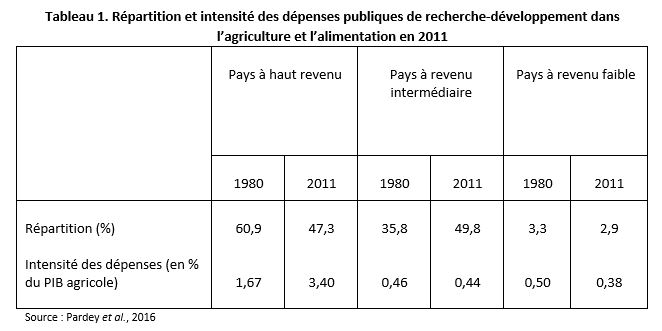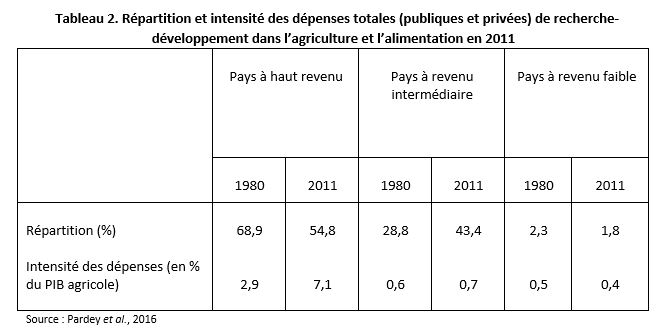SOS R&D
While the challenges of achieving the Sustainable Development Goals require a massive innovation effort, countries are struggling to invest more in agriculture and food. Budgets allocated to this sector are growing less quickly than agricultural production. The situation is particularly worrying in low-income countries.
Feeding populations better, in quantity and quality; reducing greenhouse gas emissions from crops and livestock and adapting agricultural production to climate change; halting the erosion of biodiversity by curbing the use of chemical inputs and without encroaching on forests… These are all necessary but very ambitious objectives, which require that States devote more resources to research and disseminating its results to farmers. However, this is not the case today.
Lower intensity of public support for knowledge and innovation
Certainly, according to the OECD, public spending on the "agricultural knowledge and innovation system" - including agricultural research, training, and extension - is steadily increasing in major high-income countries and middle-income (or emerging) countries. But its intensity, i.e. its amount expressed as a percentage of the value of agricultural production, is decreasing. According to our calculations, it averaged 0.73 % over the period 2017-19, compared to 0.92 % in 2000-02. This relative decline concerns both OECD member countries, in other words essentially rich countries (from 1.20 % to 1.14 % over the period studied), and non-OECD emerging countries, including Brazil, China, India, and Russia (from 0.57 % to 0.54 %).[1].
This is a worrying finding. It is even more so when we consider low-income countries, which account for 9.1 billion of the world's population but account for less than 3.1 billion of global spending on research and development (R&D) in agriculture and food. (table 1).

These countries in fact have several weak points:
- according to the latest available data[2], the intensity of agricultural R&D expenditure in poor countries, expressed as a percentage of agricultural gross domestic product (GDP), is very low: it fell from 0.50 % in 1980 to 0.38 % in 2011, compared to 0.44 % in emerging countries and 3.40 % in rich countries. In other words, in 2011, the public effort in agricultural R&D in low-income countries was proportionally nine times lower than that observed in high-income countries. Moreover, this gap has widened: in 1980, it was "only" 1 to 3;
- the volatility of public agricultural R&D spending is much higher in low-income countries[3]. It is not uncommon, in fact, for the amount of these expenses to vary significantly from one year to the next within the same country. This instability is, of course, detrimental to the continuity and productivity of research.
The situation in sub-Saharan Africa is instructive. In this region, in 2011, public spending on agricultural R&D was equivalent on average to 0.40 % of the value of agricultural GDP, compared to 0.67 % in 1980. Their intensity further decreased to 0.39 % in 2016, a level well below the target of 1 % set by the African Union to use resources dedicated to agriculture more efficiently and thus produce more while limiting the expansion of cultivated areas.[4].
Growing share of private research
However, these figures do not tell the whole story. Private spending on agricultural research and development is growing much faster than public spending. In 2011, it represented, at the global level, 45% of total agricultural R&D spending, compared to 35% in 1980. Since the private sector invests mainly in high-income countries (and, to a lesser extent, in emerging countries), the relative deficit in agricultural research in low-income countries is amplified accordingly. In 2011, the intensity of total spending (public and private) on agricultural R&D in these countries was almost 18 times lower than that in high-income countries. (table 2)In sub-Saharan Africa, the gap was on average 1 to 14.

However, private research is complementary to public research, but it only targets innovations likely to generate profit and neglects certain applications which are nevertheless of collective interest. "We should not naively believe that every profitable innovation inevitably responds favorably to all the relevant questions for society, nor that every socially desirable innovation offers private investment an advantageous rate of return.", warns a panel of experts from Cornell University[5].
While multiple studies show that the return rates of public agricultural R&D are very high[6], a sign of obvious underinvestment, it is alarming to observe that public research is declining, in relative terms, compared to private research, including in high-income countries[7]. And that the governments of poor countries do not make it a priority, due to a lack of financial resources or political will, even though the majority of their active population works in agriculture. Given the latency period, at least 10-15 years, between investment in research and its concrete benefits, today's choices are preparing for a disillusioning tomorrow.
[1] OECD, Agricultural Policy Monitoring and Evaluation 2020.
[2] Pardey P. et al., 2016. Shifting Ground: Food and Agricultural R&D Spending Worldwide, 1960-2011. InSTePP Center at the University of Minnesota. Due to insufficient information, this publication does not include agricultural research expenditures in the former USSR and Eastern European countries. According to another source, however, these represent only a small share (3.6 % in 2011) of global public agricultural R&D expenditures (Fuglie, K. And al., 2020. Harvesting Prosperity: Technology and Productivity Growth in Agriculture. World Bank).
[3] Stuti R., 2020. Global volatility of public R&D expenditure. Advances in Food Security and Sustainability.
[4] An acceleration of agricultural R&D spending in sub-Saharan Africa, from 0.39 % to 1 % of agricultural GDP, would increase total factor productivity in agriculture by more than 60 % by 2050. Source: IFPRI, Global Food Policy Report 2020.
[5] Barrett C. et al., 2020. Socio-technical Innovation Bundles for Agri-food Systems Transformation, Report of the International Expert Panel on Innovations to Build Sustainable, Equitable, Inclusive Food Value Chains. Cornell Atkinson Center for Sustainability/Nature Sustainability.
[6] The cost-benefit ratio of public agricultural research in middle- and low-income countries is in the order of 1 to 10, mainly due to the effects of agricultural productivity gains on reducing the cost of food and reducing poverty. Source: Alston, JM et al., 2020. The Payoff to Investing in CGIAR Research. SoAR Foundation.
[7] The private sector's share of total agricultural R&D expenditure in high-income countries increased from 42% in 1980 to 52% in 2011. Source: Pardey P. et al., 2016. Shifting Ground: Food and Agricultural R&D Spending Worldwide, 1960-2011. InSTePP Center at the University of Minnesota.
